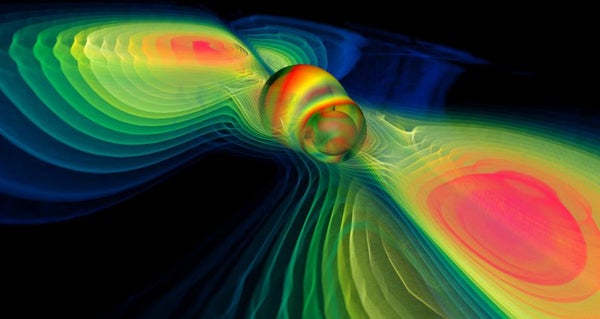This article was published in Scientific American’s former blog network and reflects the views of the author, not necessarily those of Scientific American
“Now that LIGO has detected gravitational waves, what will you do next?” was a question I got from a surprising number of people. It was February 2016, and LIGO (the Laser Interferometer Gravitational-Wave Observatory) had announced its first detection: gravitational waves emitted from a pair of black holes as they spiraled in and smashed into each other. As a master’s student, I had just started research in this field. My highly optimistic response was: “This is just the beginning. LIGO is going to routinely make new scientific discoveries that will give us researchers a lot of sleepless nights.”
More than three years later, LIGO and its European counterpart Virgo have lived up to that promise: so far, they’ve found 21 mergers of binary black holes and three mergers involving binary neutron stars. And in the wee hours of September 24, the “sleepless nights” prediction came true: my phone woke me up with an message from a new LIGO-Virgo public notification system that alerts subscribers within minutes of a new detection.
I’m someone who enjoys a sound sleep more than anything else, but I never complain when the universe calls—and this particular alert was especially worth waking up for. The reason: not only had the collaboration made a detection, but it was a new kind of event involving an object belonging to a mysterious gray area known as the “mass gap.”
On supporting science journalism
If you're enjoying this article, consider supporting our award-winning journalism by subscribing. By purchasing a subscription you are helping to ensure the future of impactful stories about the discoveries and ideas shaping our world today.
To understand what that means, we need to delve deeper into the kinds of objects LIGO-Virgo studies. I have always been fascinated by matter at the most extreme densities. Objects such as neutron stars and stellar-mass black holes weigh as much as a star but have a diameter that is only about the size of a large city. They form when very big stars, weighing more than eight times the mass of the sun, run out of their nuclear fuel and explode as supernovae.
What’s left depends on how much of the star’s core remains. The lighter cores tend to form neutron stars, while the heavier ones tend to collapse uncontrollably under their own gravity and turn into black holes.
But things get fuzzy at this point: we can’t say precisely where the line between “lighter” and “heavier” falls. Theoretically, the heaviest a neutron star can be is about three times the mass of the sun—but we’ve never been able to adequately test that theory with observations. The heaviest neutron star ever observed, weighing in at about 2.14 solar masses, was recently announced in the journal Nature Astronomy. And the lightest black holes we’ve seen weigh around five solar masses. We’ve never convincingly observed anything in the space between three and five—a range we call the mass gap.
The closest we have come was when LIGO-Virgo detected the first merger of binary neutron stars in August 2017. The result of their collision is an object estimated to weigh around 2.8 solar masses, tantalizingly close to the lower bound of our mass gap. Whether it is a neutron star or black hole remains unresolved to this day.
It may sound like an obscure question to worry about, but for physicists such as me, this uncertainty is a really big deal. If the mass gap is real—if there’s truly nothing to be found in that range—it will force theorists go back to their blackboards to review their ideas of the physics of supernovae. And if there is no gap, and there is actually a sharp dividing line, we need to figure out why we haven’t seen objects in that intermediate range.
That is why all eyes, including mine, immediately focused on the September alert. The pattern of gravitational waves emitted when pairs of compact objects revolve around each other gives us a totally new method of estimating the mass of each body. If a mass-gap object underwent such a collision with another compact object, LIGO-Virgo would definitely catch the distinctive ripples that emerged.
In fact, the September event was not the first time a public alert has been issued for a mass-gap object. A month earlier, LIGO-Virgo sent out a similar message. But less than 12 hours later, it released updated probabilities, which downgraded the likelihood of the object falling within the mass-gap to under 1 percent.
Despite the dashed hopes of having our first mass-gap detection, that event gave us plenty of reason to remain jubilant: it holds the promise of being the first time we have seen the merger of a neutron star and a black hole.
As for the most recent detection that woke me up: researchers at LIGO-Virgo are now hard at work churning data-analysis codes to confirm whether it really contains an object that fills in the existing void. It would help us finally determine what the nature of these objects is. Most researchers, myself included, would bet on them being “missing” lightweight black holes that we just had not been able to see with previous methods. But alternative theories also suggest this void may be filled with exotic objects such as stars made entirely of quarks.
Whatever the outcome, the current LIGO-Virgo observing run encapsulates the excitement of cutting-edge research that hooked me into this field in the first place. What’s even better is that you can share in the fun. Anyone can subscribe to the public alerts that woke me that night in September. There’s even an app for receiving them. So keep your phone handy, and you, too, can get a message from the universe.
